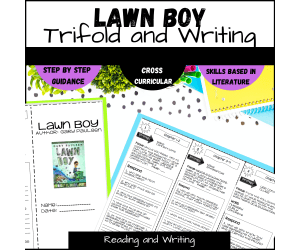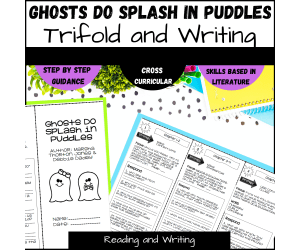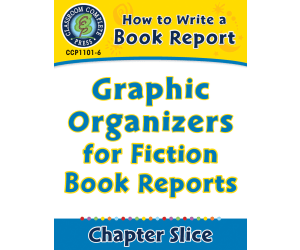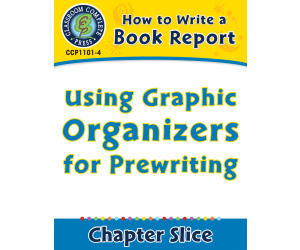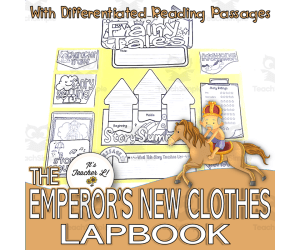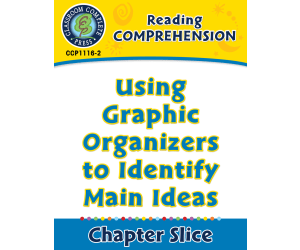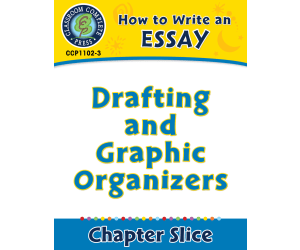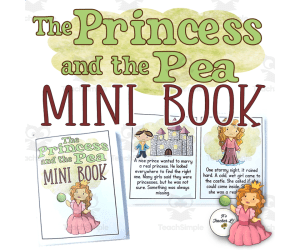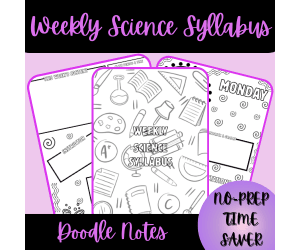2,769 products added recently
ELA Graphic Organizers
Enrich your English Language Arts instruction with graphic organizers that aid in understanding and organizing literary elements, writing structures, and vocabulary. This collection includes story maps, essay planners, and vocabulary webs. By integrating these tools, you can facilitate deeper engagement with texts and improve communication skills.
The Steadfast Tin Soldier Lapbook Project Reading Writing Grades 3 4 5
Language Development, ELA, ESL, Literature, Literary Devices, Children’s Literature, Reading Comprehension, Reading, Strategies, Grade 3, 4, 5, Activities, Crafts, Centers, Projects, Graphic Organizers, Teacher Tools, Templates
Encourage strength of spirit through the classic tale of The Steadfast Tin Soldierwith this The Steadfast Tin SoldierLapbook Project . This purposeful resource is created for Grades 3, 4, and 5 students, homeschoolers and EFL/ESL learners and designed to be used for reading classes, reading centers, fairy tale units, reading comprehension assessment tool, sub plan and more! Contents: •3 The Steadfast Tin SoldierLapbook Leveled Reading Passages (Easy, Average, and Hard) •6 The Steadfast Tin SoldierLapbook Cover Options •2 The Steadfast Tin SoldierLapbook Name Page Designs (for individual or group use) •1 The Steadfast Tin SoldierLapbook Inner Overlap Panel •3 The Steadfast Tin SoldierLapbook Story Summary Page Formats •2 The Steadfast Tin SoldierLapbook Thematic Message Pages •2 The Steadfast Tin SoldierLapbook Pockets for Story Sequence Cards •6 The Steadfast Tin SoldierLapbook Illustrated Sequence •3 The Steadfast Tin SoldierLapbook Sets of Sequencing Cards – Easy, Average, and Hard (6 cards each) •6 The Steadfast Tin SoldierLapbook Story Retell Cards •1 The Steadfast Tin SoldierLapbook Character Traits Fold •1 The Steadfast Tin SoldierLapbook Story Setting Fold •1 The Steadfast Tin SoldierLapbook Additional Information Foldable •1 The Steadfast Tin SoldierLapbook Story Rating Page •1 The Steadfast Tin SoldierLapbook Reflection Fold
Author It's Teacher L
Rating
Tags The Steadfast Tin Soldier, Fairy Tales, Reading Comprehensio, Reading Centers, ELA Project
Overcoming Temptation Bible Lesson
Resources for Teachers, Research, Life Studies, Reading, ELA, Writing, High School, Homeschool Resources, Middle School, Teacher Tools, Worksheets & Printables, Writing Prompts, Graphic Organizers, Literacy Readers
Let's face it—being a teenager today is tough. That's why I created this Overcoming Temptation Bible Lesson with your students/homeschoolers in mind. I have packed 46 pages with real-talk strategies that are both deeply rooted in Scripture and actually useful in their everyday lives. No stuffy language here—just honest conversation that meets teens where they are while pointing them toward God's truth. As they work through each lesson, they will go from just understanding what temptation is to walking away with their own spiritual game plan they have created themselves. I have worked hard to connect the timeless wisdom of the Bible with what teens actually deal with: the constant pull of social media, complicated friendships and dating relationships, pressures around substances, and those moments when cheating on that test seems like the only option. INCLUDED IN THIS RESOURCE: 46 pages with teen-friendly language and formatting Scripture references from both Old and New Testaments with context explanations Personal reflection questions to promote deeper engagement Practical application strategies students can implement immediately Real-world examples addressing modern temptations teens actually face A customizable personal action plan template for lasting change TOPICS INCLUDED: Defining temptation and its universal nature across all believers Identifying common sources and triggers of temptation for teenagers Examining Jesus' wilderness temptation as a practical example Understanding the progressive nature and dangers of giving in to temptation Implementing Scripture memorization and prayer as spiritual weapons Developing healthy community and accountability relationships When you invest in this Bible study, you are giving teenagers something that goes far beyond a few weeks of lessons—you are helping them build spiritual muscles they will use for life. In a world where teens are bombarded with mixed messages, this resource does not just teach them to say "no" to the wrong things; it helps them embrace a vibrant "yes" to God's best for them. I have carefully crafted both the opening welcome and final send-off to bookend the experience with encouragement that sticks. My goal is that your students/homeschoolers will still be drawing on these biblical principles years from now as they navigate college decisions, workplace ethics, and relationships. There is something powerful about seeing a teenager connect with God's Word in a way that actually makes sense to them—and that is exactly what this resource helps make happen. If you and your homeschoolers enjoyed this resource, please leave a review. Tina - Big Easy Homeschooling Mom
Author Homeschool with Big Easy Homeschooling Mom
Rating
Tags Teen Devotional, Character Development, Spiritual Growth For Teens, Biblical Strategies For Temptation, Biblical Decision-Making, Teenage Spiritual Formation, Bible Lessons For High School Students/Homeschoolers, Christian Character Development, Faith-based Decision Making For Teens, Teen Discipleship Material
Guided Reading Activity Lawn Boy Book Report Trifold
ELA, Reading, Grade 3, 4, 5, Activities, Projects, Teacher Tools, Graphic Organizers, Worksheets & Printables, Novel Studies
Lawn Boy by Gary Paulsen tells the story of a 12-year-old boy who transforms a simple lawn-mowing gig into an unexpectedly booming business. Through quirky clients, a surprising stock market investment, and the involvement of a professional boxer, the boy learns about responsibility, success, and the unpredictable twists of entrepreneurship. With humor and insight, Lawn Boy captivates readers while sparking conversations about economics, character growth, and life lessons. This trifold activity is created to help students practice reading comprehension skills while providing differentiated instruction for various reading levels. Trifolds can be utilized during guided reading, as independent seat work, or in literature circles. The included writing wrap-up allows for assessing multiple skills in one cohesive project, making it an ideal, standards-aligned resource for busy teachers. Multiple subjects can be assessed, including reading skills, reading comprehension, and writing reflection. What’s Included in This Resource: Each trifold is broken down by chapters or pages and allows chunking of information for easy teacher planning and appropriate student use. In each trifold, the following skills are assessed: Making Connections: Encourage students to relate the story to their own lives, other texts, and the wider world. Making Inferences: Help students combine text evidence with prior knowledge to draw logical conclusions. Using Context Clues: Teach students to deduce the meaning of unfamiliar words using hints from the text. Visualization: Support students in creating mental images of characters, events, and settings. Evaluation: Develop critical thinking by analyzing characters, themes, and the author’s message. Writing Wrap-Up: A writing assessment tool for reflection and deeper understanding. How This Resource Benefits Teachers: ✔ Provides differentiated instruction for diverse learners. ✔ Fosters text engagement and critical thinking with content. ✔ Offers flexibility for grades, seat work, or group discussions. What Teachers Are Saying: ⭐ "This resource made my guided reading groups more organized and productive!" - Rebecca T. ⭐ "Perfect for differentiation and keeping all students engaged at their level." - Larraine C. ⭐ "My students loved the activities, and it worked seamlessly in our literature circles!" - Celia N.
Author Kel's Klass
Tags Trifold, Reading Project, Gary Paulsen, Making Inferences, Making Connections, Lawn Boy, Guided Reading Activity, Context Clues, Evaluation, Visualization
Guided Reading Activity Ghosts Do Splash in Puddles Trifold Book Repor
ELA, Reading, Grade 2, 3, 4, Activities, Projects, Teacher Tools, Graphic Organizers, Novel Studies, Worksheets & Printables
Ghosts Do Splash in Puddles by Marcia Thornton Jones and Debbie Dadey dives into the adventures of the Bailey School Kids as they investigate a mysterious, translucent figure spotted splashing in puddles on a rainy day. With humor and determination, the kids uncover clues and navigate friendships, making this story a delightful choice for young readers. This trifold resource is created to help students practice reading comprehension skills while providing differentiation for various reading levels. This tool can easily be utilized during guided reading, independent seat work, or literature circles. The included writing wrap-up allows for assessing multiple skills in one project, making it perfect for teachers looking for projects that can cover multiple subjects - reading comprehension, reading skills, and writing. What’s Included in This Resource: Each trifold is broken down by chapters or pages and allows chunking of information for easy teacher planning and appropriate student use. In each trifold, the following skills are assessed: Making Connections: Encourage students to relate the story to their own lives, other texts, and the wider world. Making Inferences: Help students combine text evidence with prior knowledge to draw logical conclusions. Using Context Clues: Teach students to deduce the meaning of unfamiliar words using hints from the text. Visualization: Support students in creating mental images of characters, events, and settings. Evaluation: Develop critical thinking by analyzing characters, themes, and the author’s message. Writing Wrap-Up: A writing assessment tool for reflection and deeper understanding. How This Resource Benefits Teachers: ✔ Provides differentiated instruction for diverse learners. ✔ Fosters text engagement and critical thinking with content. ✔ Offers flexibility for grades, seat work, or group discussions. What Teachers Are Saying: ⭐ "This resource made my guided reading groups more organized and productive!" - Rebecca T. ⭐ "Perfect for differentiation and keeping all students engaged at their level." - Larraine C. ⭐ "My students loved the activities, and it worked seamlessly in our literature circles!" - Celia N.
Author Kel's Klass
Tags Reading Strategies, Trifold Project, Guided Reading, Ghosts Do Splash In Puddles, Bailey Kids, Making Connections, Making Inferences, Context Clues, Evaluating, Visualization
What are Myths, Fables, Legends, and Fairy Tales?
ELA, Literature, Reading, Writing, Grade 3, 4, 5, Drawing Templates & Outlines, Worksheets & Printables, Worksheets, Graphic Organizers, Teacher Tools, Outlines
Brief Activity Overview: In this activity, your child will explore the unique features of myths, fables, legends, and fairy tales . They will watch a short video and use a chart to organize what they’ve learned about each type of story. At the end of this document, be sure to check out the "Beyond the Activity" section for fun extension ideas if your child wants to dive deeper into these story types or try related lessons. Estimated Time: Less than 1 hour Learning Objective: Understand and identify key features of myths, fables, legends, and fairy tales. Subject: English Language Arts Recommended Grade Levels: 3rd – 6th Getting Started: Exploring Story Types Begin by engaging your child in a simple conversation to spark interest and activate prior knowledge: Tell me about one of your favorite storybooks. Suggested discussion questions are included as great way to ease into the lesson and connect your child’s personal reading experiences to the bigger ideas behind storytelling. Introducing the Activity Discuss how many stories fall into categories such as myths, fables, legends, and fairy tales and what your child knows about them (guiding questions are provided). Then, explain that in this activity, they’ll learn more about each type by watching a brief video and taking notes. Encourage them to pay attention to the key features of each story type and notice how they are alike and different . What to Do Next Watch the Video – Invite your child to watch the short video provided. Take Notes – As they watch, encourage them to jot down what they learn about myths, fables, legends, and fairy tales. Discuss and Reflect – After watching, go over the comprehension questions on the next page. These questions can be used: As discussion starters As writing prompts Or a combination of both—whatever works best for your family! 💡 An answer key is included to support your discussion.
Author Sprout & Inspire
Rating
Tags Reading, Myth, Fable, Legend, Fairy Tale, Graphic Organizer, Quick Activity, Ela
SUPER PACK | 10 FREE READINGS | TEXT+QUESTIONS+ANCHOR CHARTS
Reading, ELA, Writing, Adult Education, Elementary, High School, Homeschool Resources, Middle School, Not Grade Specific, Early Learning, Anchor Charts, Teacher Tools, Assessments, Charts, Graphic Organizers, Quizzes and Tests, Workbooks, Worksheets & Printables
SUPER PACK | 10 FREE READINGS | TEXT+QUESTIONS+ANCHOR CHARTS ABOUT THE AUTHOR: At EDITORIAL ARENAS EDUCATIVAS, we believe that learning should be as fun as playing. That’s why we create educational materials that spark children’s curiosity and creativity. I invite you to check out my educational store and discover the wide range of resources that can transform your classes. MAIN DESCRIPTION: What is the name of the product? Hello! Thank you so much for being interested in this beautiful and fabulous product that you can use with your children, both at school and at home. The name of this fabulous product is: SUPER PACK | 10 FREE READINGS How many pages does it include? This educational document, carefully created and in some cases compiled, has the following number of pages: 200 What format is it in (A4, letter, digital, printable)? This educational resource is designed in A4 format and PDF, so you will have no difficulties printing it and it will also stay well-protected. PDF A4 SUMMARY OF THIS PACK: What is the name of the document?: SUPER PACK | 10 FREE READINGS How many pages does it include?: 20 In what format is it available (PDF, Word, PPT)?: PDF Is it in color or black and white?: COLOR EXTRA INFORMATION: What type of resource is it (activities, guide, set, bundle, workbook)? This resource, like many others, can be an activity or a guide. I also invite you to visit my educational store, where you will find a variety of resources such as games, worksheets, and assessments. For what age, grade, or school level is it ideal? I usually create resources for early grades (children ages 3–5), but I also design for primary students (ages 7–12). My priority is to make children’s learning creative. What learning area does it focus on? This and all my resources focus on children’s essential learning, such as math and literacy. Occasionally, I also create resources for Spanish. What will students learn or practice with it? With this educational resource, children will be able to practice basic skills in math and literacy. Teachers can also adapt it to other learning areas, since learning is multidisciplinary.
Author EDITORIAL LAURA EDUCA
Rating
Tags FREE, FREE RESOURCES, PACK, SUPER PACK, BUNDLE, READINGS, TEXT, ELA, READING, READING AND COMPREHENSION
How to Write a Book Report: Graphic Organizers for Oral Book Reports
ELA, Writing, Common Core, Grade 5, 6, 7, 8, Graphic Organizers, Teacher Tools
Teaching Resource Overview 'How to Write a Book Report: Graphic Organizers for Oral Book Reports' is an indispensable tool for educators, especially ideal for those imparting language arts focused on writing aspects to students in grades 5 through 8. The content of this resource offers practical guidelines from initial drafting to final revision, making the process of writing book reports simple and comprehensive. Tackling Challenges Head-On Acknowledging that students can perceive book reports as overwhelming tasks, the product focuses on mastering this crucial academic undertaking. Included in its package are graphic organizers meant to be used during the prewriting stage. These tools facilitate strong foundational thinking and streamline organization before the actual writing begins. Beyond Draft Creation Not just assisting with creating detailed drafts, 'How to Write a Book Report: Graphic Organizers for Oral Book Reports' equips educators with additional tools necessary for successfully implementing related report-writing lessons. These include: A student assessment rubric Intriguing word puzzles Comprehension quizzes designed for sustained student engagement Crafting Skills effectively – The Visual Aids Advantage This teaching resource contains six color graphic organizers which introduce skill focus effectively while guiding learners through various writing process stages. Distributing Learning Material Effortlessly An added convenience offered by 'How To Write A Book Report: Graphic Organizers For Oral Book Reports' is being equipped with 24 ready-to-print PDF pages which simplifies distribution among students fitting into multiple learning scenarios such as: Whole-group instruction Smaller breakout groups or even individual assignments addressing specific learning needs. Enhancing Student Proficiency This comprehensive lesson plan is aligned with both Common Core State Standards and Bloom's Taxonomy. It not only supports current academic programs but also independently elevates student proficiency levels in report-writing skills which directly contributes towards their overall academic success.
Author Classroom Complete Press
Tags Language Arts, Writing, Book Reports, Graphic Organizers, Language Activity
How to Write a Book Report: Graphic Organizers for Fiction Book Reports
ELA, Writing, Common Core, Grade 5, 6, 7, 8, Graphic Organizers, Teacher Tools
**This is the chapter slice "Graphic Organizers for Fiction Book Reports" from the full lesson plan "How to Write a Book Report"** Do your students groan in despair when book reports are assigned? Our workbook provides opportunities for students to use graphic organizers during the prewriting process and offers clear and concise instruction in the drafting and revision phases. The learning objectives contained are based on Bloom’s Taxonomy and provide instruction in the correct form and mechanics of all book reports. You can use this material to supplement your present writing program or for independent student work. Also included is a detailed implementation guide, student assessment rubric, word puzzles and comprehension quiz. The six color graphic organizers will assist the introduction of the skill focus and in guiding your students through their successful writing process. All of our content meets the Common Core State Standards and are written to Bloom's Taxonomy.
Author Classroom Complete Press
Tags Language Arts, Writing, Book Report, Graphic Organizers, Fiction Text, Written Book Reports By Students
How to Write a Book Report: Using Graphic Organizers for Prewriting
ELA, Writing, Common Core, Grade 5, 6, 7, 8, Graphic Organizers, Teacher Tools
How to Write a Book Report: Using Graphic Organizers for Prewriting This resource is designed to aid in the education of students, focusing on the organization of thoughts and ideas before they begin writing book reports. Ideal for students between grade 5 and 8, this resource falls squarely within the Language Arts category with an emphasis on enhancing writing skills. The primary function of this tool is to revolutionize the often daunting task of book report assignments by using easily accessible graphic organizers during prewriting. These handy devices guide students through organizing their thoughts concerning key elements such as plot structure, character characteristics, and themes which are essential in creating engaging book reports. A well-organized outline aligns with Bloom's Taxonomy learning objectives; this resource encourages a progressive learning method gliding students gradually from understanding facts through synthesis and evaluation stages - guiding each step along the way to completing polished reports that strictly adhere to proper forms and mechanics. Besides being just a teaching tool, educators can use this resource creatively - whether as supplementary material complementing an ongoing writing program or self-sufficient activities assigned at home. The inclusive package doesn't only include exciting word puzzles enhancing language skills but also comprehension quizzes significantly instrumental in determining student's grasp level over learned concepts. To ensure flawless execution of preset activities included in lesson plans, there’s added reassurance with inclusion of detailed guides breaking down how tasks should be approached. An additional feature includes easy-to-use student assessment rubrics simplifying grading process while ensuring fair basis during marking exercise - offering overall a systemically designed educational experience bundling together both learning and assessment processes neatly organized within one place. Kept flexible via maintaining it available on PDF; it enables usage electronically during virtual classes or printed paper copies accommodating varied class systems from whole group teaching to small group combined studies. This promising writing developmental course for intermediate level students, adheres strictly to the Common Core State Standards and is thoughtfully curated implementing Bloom's Taxonomy techniques forming its fundamental foundation.
Author Classroom Complete Press
Tags PDF
The Emperor’s New Clothes Lapbook Project ELA Grades 3 4 5
ELA, Language Development, ESL, Reading Comprehension, Reading, Strategies, Literature, Literary Devices, Children’s Literature, Grade 3, 4, 5, Centers, Activities, Crafts, Projects, Assessments, Teacher Tools, Graphic Organizers, Templates
Start the parade through the classic tale of The Emperor’s New Clotheswith this The Emperor’s New ClothesLapbook Project! Perfect for reading classes, ELA activities, reading centers, reading comprehension supplemental tool, reading project, subplan and so much more! What’s Inside: 3 The Emperor’s New ClothesLapbook Leveled Reading Passages (Easy, Average, Hard) 6 The Emperor’s New ClothesLapbook Customizable Lapbook Covers 2 The Emperor’s New ClothesLapbook Name Page Formats (for solo or group project) 1 The Emperor’s New ClothesLapbook Inner Overlap Template 3 The Emperor’s New ClothesLapbook Story Summary Pages 2 The Emperor’s New ClothesLapbook Moral Message Pages 2 The Emperor’s New ClothesLapbook Event Pockets 6 The Emperor’s New ClothesLapbook Story Sequence Cards 3 The Emperor’s New ClothesLapbook Sets of Sequence Cards (graded by difficulty – 6 per set) 6 The Emperor’s New ClothesLapbook Retelling Cards 1 The Emperor’s New ClothesLapbook Character Traits Fold 1 The Emperor’s New ClothesLapbook Setting Fold to 1 The Emperor’s New ClothesLapbook Extra Info Fold 1 The Emperor’s New ClothesLapbook Story Review Page 1 The Emperor’s New ClothesLapbook Personal Reflection Fold
Author It's Teacher L
Rating
Tags The Emperor's New Clothes, Reading Comprehension, Fairy Tale, ELA Project, Reading Centers
Reading Comprehension: Using Graphic Organizers to Identify Main Ideas
ELA, Reading, Reading Comprehension, Common Core, Grade 5, 6, 7, 8, Graphic Organizers, Teacher Tools
Reading Comprehension: Using Graphic Organizers to Identify Main Ideas This valuable teaching resource, entitled "Reading Comprehension: Using Graphic Organizers to Identify Main Ideas", serves as a crucial tool for enhancing students' reading skills. Created primarily for student education in grades 5 through 8, this resource focuses on promoting an understanding of Language Arts and specifically targets pertinent comprehension techniques. The Aim The paramount aim of our Reading Comprehension guide is the teaching and mastery of fundamental reading abilities, which are integral to achieving comprehension fluency in all subject areas and contexts. Given the primacy of reading as a communicative skill in our society, this guide places strong emphasis on many foundational building blocks central to the acquisition of excellent reading skills. Applying context clues for better text understanding Determining the main idea underlying written material Making valid interpretations and logical inference from written content The Added Benefits This teaching resource supports educators by providing clear explanations comprising definitions of crucial terms that aid children's understanding. A key incentive offered by this guide is its user-friendly interface; interspersed within are multiple opportunities for learners to reinforce their gained skills via practice exercises. Additionally, the learning objectives embedded within our books adhere strictly to Bloom’s Taxonomy of Learning constructs—providing high usability assured educational relevance—and meet Common Core State Standards criteria. This versatile tool facilitates both whole group instruction—to manage a more generalized learning program—as well as small group instructional segments possibly aimed at helping individuals tackle specific challenges or difficulties encountered during independent study or homework assignments. Digital Format Features Fully digitally formatted material is at your disposal. With a complete PDF of 24 easily accessible pages ready for immediate printing, this educational asset proves invaluable while formulating lesson plans aimed at instilling extensive knowledge on comprehension strategies in students.
Author Classroom Complete Press
Tags Language Arts, Reading, Comprehension, Graphic Organizers, Main Idea
How to Write an Essay: Drafting and Graphic Organizers
ELA, Writing, Common Core, Grade 5, 6, 7, 8, Graphic Organizers, Teacher Tools
How to Write an Essay: Drafting and Graphic Organizers - A Valuable Educational Tool This remarkable teaching resource is a highly recommended tool for educators committed to enhancing the writing skills of their students. Contained within are 24 printable pages in PDF format, offering meticulously designed lessons that focus on essay writing suitable for Grade 5 through Grade 8 students. Ease of Learning Moving from drafting, refining language skills, unto effectively applying graphic organizers – it covers everything. Utilizes engaging and interactive methods rather than traditional instruction. Bases its educational foundations on Bloom’s Taxonomy, enabling higher order learning. Rich Content & Versatility Suitable for training in various formats such as narrative essays or persuasive articles along with comprehensive grammar exercises. Serves as standalone material or supplementary resource with inbuilt assessment rubrics & comprehension quizzes tailored perfectly to fetch maximum results. 'How to Write an Essay: Drafting and Graphic Organizers' caters excellently whether implemented in whole class sessions or addressing individual needs, making it an indispensable guide for daily classroom activities or strategic lesson planning. The Added Edge - Graphic Organizers The six colorfully designed graphic organizers not only add vibrancy but serve as crucial roadmaps guiding students towards creating well-structured compositions. Positioned appropriately within the Common Core State Standards framework besides being rooted at varying Bloom's taxonomy levels - this ensures holistic education becomes almost intuitive! Your Ultimate Goal Achieved Easily! If you're an educational professional committed to inspiring your students and fostering creativity and critical thinking skills, this tool would prove invaluable. It succeeds in emboldening young minds to exceed the mediocre, embracing a world of creativity and analytical discourse.
Author Classroom Complete Press
Tags Writing An Essay, Drafts, Graphic Organizer, Writing Process, Language Arts
OREO Opinion Writing Graphic Organizers
Writing, ELA, Language Development, Grammar, ESL, Grade 2, 3, 4, 5, Worksheets & Printables, Centers, Activities, Graphic Organizers, Teacher Tools
These graphic organizers help kids in grades 2-5 write better opinion pieces. When students need to write about what they think, these templates make it much easier. This set is in a PDF format and printable. It consists of 10 pages of worksheets. The main organizer uses OREO (Opinion, Reason, Evidence, and Restate). It's a simple way for kids to remember all the parts they need in their writing. Just like the cookie! You also get a pros & cons chart so students can think about good and bad points before they decide what they think. There's a Fact vs. Opinion Chart that helps kids tell the difference between what's real and what someone thinks. The Persuasive Writing Map guides students to develop a clear beginning, middle, and end. The Paragraph Frame provides sentence starters to get their ideas flowing. These work great for writing time, centers, small groups, or when kids work alone. Just print them out and you're ready to go. Use them for regular classwork, homework, or even tests. The best part? Kids actually understand how to use them. They break down opinion writing into small, easy steps. #OpinionWriting #PersuasiveWriting #OREOWritingStrategy #WritingGraphicOrganizer #ParagraphWriting #FactandOpinion #ProsandCons #WritingFrames #LiteracyCenters #WritingActivities #Elementary #Grade2 #Grade3 #Grade4 #Grade5
Author Cutie worksheets986
Rating
Tags Opinion Writing, Persuasive Writing, OREO Writing Strategy, Writing Graphic Organizer, Paragraph Writing, Fact And Opinion, Pros And Cons, Writing Frames, Literacy Centers, Writing Activities
The Nightingale Lapbook Project Reading & Writing Grades 3 4 5 ELA
ESL, Language Development, ELA, Literary Devices, Literature, Reading Comprehension, Reading, Strategies, Grade 3, 4, 5, Centers, Activities, Crafts, Projects, Assessments, Teacher Tools, Graphic Organizers, Templates
Discover the amazing tale of The Nightingalethrough this dynamic The Nightingale Lapbook Project made especially for Grades 3, 4, and 5 learners, homeschoolers and EFL/ESL students. This interactive resource is packed with activities for your reading class, reading centers, ELA projects, fairy tale units, and reading comprehension assessment tool and so much more! What’s Inside: •3 The Nightingale Lapbook Leveled Reading Passages (Easy, Average, Hard) •6 The Nightingale Lapbook Unique Cover Options •2 The Nightingale Lapbook Name Page Versions (for individual and group projects) •1 The Nightingale Lapbook Center Page •3 The Nightingale Lapbook Story Summary Templates •2 The Nightingale Lapbook Theme and Message Pages •2 The Nightingale Lapbook Sequencing Pockets •6 The Nightingale Lapbook Picture Event Cards •3 The Nightingale Lapbook Event Sequencing Sets – Easy, Average, Hard (6 cards each) •6 The Nightingale Lapbook The Nightingale Lapbook Retell Cue Cards •1 The Nightingale Lapbook Character Foldable •1 The Nightingale Lapbook Setting Accordion Fold •1 The Nightingale Lapbook Story Elements Foldout •1 The Nightingale Lapbook Book Rating Page •1 The Nightingale Lapbook Personal Connection Page
Author It's Teacher L
Rating
Tags The Nightingale, Reading Comprehension, ELA Project, Reading Centers
Literary Devices: Using Graphic Organizers to Identify Setting
ELA, Literature, Common Core, Grade 5, 6, 7, 8, Graphic Organizers, Teacher Tools
Literary Devices: Using Graphic Organizers to Identify Setting This all-encompassing educational tool focuses on the vital elements of literature such as setting, plot, theme, point of view, foreshadowing and flashback, symbolism and irony. It is not just about offering clear-cut definitions but also providing enough practice opportunities for students. Using Graphic Organizers to Identify Setting This chapter guides students in understanding how settings can define stories. By using graphic organizers – a form of visual learning -, students get better at storing information making it easier to decipher the significance of setting within a literary work. Suitability & Use This product caters follower wide range - whether executed in whole groups or small groups or given as homework. The aim here is ensuring that it adapts best according to your classroom requirements. Structured Learning: This resource aligns with Bloom’s Taxonomy of Learning ensuring its educational pertinence and efficiency. Ready-to-use: Comprising 24 pages that are ready-to-print which are contained within a single PDF file allow for convenient usage without any extra provisions needed. Matching up with Grade 5 to Grade 8 grade levels’ Common Core State Standards - this tool ensures strict adherence towards meeting expectations related to Language Arts focusing specifically on Literature subdomain. Creative Narration & Interactive Activities:The blend of engaging narration styles accompanied by involving activities like interpretation symbols or identifying storylines using graphic organizers ensures student's deep understanding about storytelling fundamentals. When you wish for improving your student's literature assessment skills effectively while having fun during that process then Literary Devices: Using Graphic Organizers To Identify Setting* proves itself as an exceptionally profitable addition. Not only does it add to their knowledge but also creates an intrigue about language arts.
Author Classroom Complete Press
Tags Language Arts, Literary, Literature, Graphic Organizers, Word Search
Weekly ELA Syllabus Doodle Notes
ELA, Writing, Resources for Teachers, High School, Homeschool Resources, Middle School, Worksheets & Printables, Writing Prompts, Teacher Tools, Graphic Organizers, Outlines, Templates
Imagine jazzing up your language arts planning with these Weekly ELA Syllabus Doodle Notes . They are not just templates; they are a fun way for teachers and students alike (including homeschoolers!) to dive into learning. Think of them as beautifully designed organizers that blend pictures with practical planning. T his combo makes mapping out your ELA curriculum not only work better but also feel more enjoyable. Each page gives you neat spots to jot down what you're doing each day, assignments, what you're reading, and writing ideas – all sprinkled with cool visuals that help things stick and get those creative juices flowing. INCLUDED IN THIS RESOURCE: ✔Comprehensive weekly ELA planning template with visually engaging design ✔Designated spaces for ELA learning objectives, content focus, and instructor information ✔Daily sections for documenting classwork, discussions, quizzes, and attendance ✔Specialized reading assignment sections for texts and primary sources ✔Homework planning areas with website research recommendations and writing prompts ✔Visual note-taking spaces that connect concepts with creative representation ✔Structured organization that accommodates the unique narrative nature of ELA instruction I've poured a lot of thought into these templates, and my hope is that they will become your go-to for language arts planning – the kind of tool that makes sure you don't miss a thing and actually makes the process a little bit of fun! You will probably find that the straightforward design helps you set clear expectations for your students (or homeschoolers), and they, in turn, will dig the visual bits that make lessons more interesting and easier to remember. Seriously, everything you need for a full ELA experience fits nicely into one good-looking and useful resource. Whether you're a seasoned homeschooling pro or just starting out as a teacher, I think you will find these templates hit that sweet spot of being organized without cramping your style. Let's shake up your language arts planning with my Weekly ELA Syllabus Doodle Notes ! I have mixed practical organization with visual learning tricks that really do the job – helping you make plans that keep everyone focused, boost memory, and get your students (or homeschoolers) more involved. Y ou might even find yourself looking forward to planning, which is saying something! Your students/homeschoolers will appreciate knowing what's coming each week, and you will love having all your ideas in one place with a bit of creative flair. Go ahead and treat yourself to this planning upgrade and see how it can bring a fresh vibe to your language arts teaching – getting organized has never felt so good! If you and your students/homeschoolers enjoyed this resource, please leave a review. Thank you for your support! Tina - Big Easy Homeschooling Mom
Author Homeschool with Big Easy Homeschooling Mom
Rating
Tags ELA Doodle Notes, ELA Organization, Visual Aids, Visual Learning Tools, Syllabus Templates, Creative Teaching Tools, Doodle Notes, ELA Planning, Weekly Planning Template, ELA Weekly Planning
Guided Reading Activity Among the Hidden Trifold Book Report
ELA, Reading, Grade 3, 4, 5, Activities, Projects, Teacher Tools, Graphic Organizers, Novel Studies, Worksheets & Printables
Among the Hidden by Margaret Peterson Haddix follows Luke Garner, a third child in a society where families are restricted to two children due to population control laws. Forced to live in isolation to avoid detection, Luke discovers another hidden child, Jen, who dreams of leading a rebellion for freedom. As their friendship grows, Luke faces life-changing decisions about courage, sacrifice, and the fight for justice in a controlled world. This trifold resource is created to help students practice reading comprehension skills while providing differentiation for various reading levels. This tool can easily be utilized during guided reading, independent seat work, or literature circles. The included writing wrap-up allows for assessing multiple skills in one project, making it perfect for teachers looking for projects that can cover multiple subjects - reading comprehension, reading skills, and writing. What’s Included in This Resource: Each trifold is broken down by chapters or pages and allows chunking of information for easy teacher planning and appropriate student use. In each trifold, the following skills are assessed: Making Connections: Encourage students to relate the story to their own lives, other texts, and the wider world. Making Inferences: Help students combine text evidence with prior knowledge to draw logical conclusions. Using Context Clues: Teach students to deduce the meaning of unfamiliar words using hints from the text. Visualization: Support students in creating mental images of characters, events, and settings. Evaluation: Develop critical thinking by analyzing characters, themes, and the author’s message. Writing Wrap-Up: A writing assessment tool for reflection and deeper understanding. How This Resource Benefits Teachers: ✔ Provides differentiated instruction for diverse learners. ✔ Fosters text engagement and critical thinking with content. ✔ Offers flexibility for grades, seat work, or group discussions. What Teachers Are Saying: ⭐ "This resource made my guided reading groups more organized and productive!" - Rebecca T. ⭐ "Perfect for differentiation and keeping all students engaged at their level." - Larraine C. ⭐ "My students loved the activities, and it worked seamlessly in our literature circles!" - Celia N.
Author Kel's Klass
Tags Reading Strategies, Trifold Project, Guided Reading, Making Connections, Making Inferences, Context Clues, Evaluating, Visualization, Among The Hidden
The Princess and the Pea Fairy Tale Foldable Mini Book Grade 1 2 3 ELA
ESL, Language Development, ELA, Children’s Literature, Literature, Reading Comprehension, Reading, Handwriting, Writing, Grade 1, 2, 3, Centers, Activities, Crafts, Projects, Assessments, Teacher Tools, Graphic Organizers
Develop the necessary literacy skills of your young learners through this purposefully made The Princess and the PeaMini Book Pack. Created for Grades 1, 2 and 3 students, homeschoolers, and EFL/ESL learners, this resource is designed for reading classes, reading centers, reading comprehension exercises, writing practice, fine motor skills exercises, fairy tale units, supplemental assessment tool, morning work, early finisher additional activities, and so much more! What’s Included: •The Princess and the PeaStory Mini Book– for story retelling, reading and reading comprehension practice •The Princess and the PeaStory Mini BookTrace & Read Pages– handwriting practice and motor skills exercise •The Princess and the PeaMini BookSequencing Booklet– sequencing and sorting exercise, story retelling and reading practice •The Princess and the PeaMini BookRetell & Reflect Pages– retell practice, creativity and imagination development •The Princess and the PeaMini BookBlank Create-a-Story Templates– story telling, supporting creative and imaginative thinking skills •The Princess and the PeaMini BookTeacher Guide + Sample Lesson Plan
Author It's Teacher L
Rating
Tags The Princess And The Pea, Reading Comprehension, ELA Project, Reading Centers
High School EOY Core Subject Doodle Note Graphic Organizer Sample Pack
Creative Arts, Graphic Arts, ELA, Math, Science, Social Studies, Resources for Teachers, High School, Homeschool Resources, Middle School, Teacher Tools, Graphic Organizers, Templates, Worksheets & Printables
Ready to wrap up your school year with something more meaningful than just clearing desks and turning in textbooks? These FREE High School End-of-the-Year Doodle Note Graphic Organizer Sample Pack is just what you need! Covering ELA, Math, History, and Science, these fun reflection templates give your students/homeschoolers a chance to look back on what they've learned, pick out their favorite topics, and think about how they'll use this knowledge in real life. I have designed these with creativity in mind - because let's face it, engaged students/homeschoolers remember more! They are perfectly sized to slip into interactive notebooks too, giving students/homeschoolers a keepsake they will actually want to look back on years from now. INCLUDED IN THIS RESOURCE: 4 ready-to-use doodle note samples (1 each for ELA, Math, History, and Science) Printable PDF format for immediate classroom use Easy-to-implement templates requiring minimal preparation Sample layouts showcasing different reflection approaches Preview of full doodle note resources available separately TOPICS COVERED: ELA: Reflection on literary favorites, writing growth, communication skills, and language arts applications Math: Year-end review of key concepts, favorite formulas, mathematical thinking development, and real-world connections History: Personal connections to historical events, perspective development, favorite historical topics, and contemporary relevance Science: Scientific inquiry reflection, concept application, experimental highlights, and future learning interests I have found these free end-of-year doodle notes do double-duty in the classroom. While students/homeschoolers are having fun reflecting on what they loved about the year's learning journey, they are actually reviewing crucial material without the stress of test prep. The visual-verbal connection helps cement those concepts in their minds one last time. My favorite part - is watching students realize how much they have grown academically when they fill out these templates. There is something powerful about giving students this creative space to wrap up their year - it brings meaningful closure while reinforcing everything they have learned in a format they actually enjoy. The science behind why these work is fascinating! Our brains process images differently than text, and when students/homeschoolers combine both on these doodle note pages , they are creating multiple pathways to remember information. I have seen this approach transform end-of-year review in my own classroom - students/homeschoolers who normally check out mentally in May stay engaged, retain more information, and connect emotionally with what they've learned. The result is Lless stress, better recall, and a positive feeling about the subjects they have studied. These free end-of-year reflection sample pages give your students/homeschoolers a chance to celebrate their academic journey while creating a memory book of their high school experience they will actually want to keep. Thank you for your support! Tina - Big Easy Homeschooling Mom
Author Homeschool with Big Easy Homeschooling Mom
Rating
Tags High School Doodle Notes, Visual Tools, Visual Learning, Core Subject Doodle Notes, Brain-based Learning, ELA Doodle Notes, Math Doodle Notes, History Doodle Notes, Science Doodle Notes, Note-taking Strategies
The Frog Prince Lapbook Project Reading & Writing Grades 3 4 5 ELA
Language Development, ELA, ESL, Children’s Literature, Literature, Reading Comprehension, Reading, Strategies, Grade 3, 4, 5, Activities, Centers, Projects, Assessments, Teacher Tools, Graphic Organizers, Templates, Crafts
Bring the magic of the timeless tale of The Frog Prince through this The Frog Prince Lapbook Project. Designed for Grades 3, 4 and 5 students, homeschoolers and ESL/EFL learners, this fun and engaging resource is perfect for reading classes, fairy tale unit, reading centers, and assessment tool for reading comprehension activities. What’s Included: •3 The Frog Prince Lapbook Differentiated Reading Passages (Easy, Average, and Hard) •5 The Frog Prince Lapbook Cover Design Choices •2 The Frog Prince Lapbook Name Page Options •1 The Frog Prince Lapbook Inner Overlap Panel •3 The Frog Prince Lapbook Story Summary Sheets •2 The Frog Prince Lapbook Story Message Pages •2 The Frog Prince Lapbook Event Sequence Pockets •6 The Frog Prince Lapbook Illustrated Photocards •3 The Frog Prince Lapbook Sequencing Sets – With 6 story cards each (Easy to Hard levels) •6 The Frog Prince Lapbook Retelling Cards •1 The Frog Prince Lapbook Character Traits Foldable •1 The Frog Prince Lapbook Setting Fold •1 The Frog Prince Lapbook Additional Information Fold •1 The Frog Prince Lapbook Story Rating Page •1 The Frog Prince Lapbook Reflection Fold
Author It's Teacher L
Rating
Tags The Frog Prince, Fairy Tale, Reading Comprehension, ELA Project
Noah’s Ark Lapbook Grades 4 5 6 Bible Story ELA PROJECT
ELA, ESL, Language Development, Children’s Literature, Literature, Reading Comprehension, Reading, Strategies, Grade 4, 5, 6, Activities, Projects, Graphic Organizers, Teacher Tools, Templates
Let your learners explore the classic Bible story of Noah’s Ark and bring the lessons of loyalty and faith through this Noah’s Ark Lapbook Project. Created for Grades 4, 5, 6, homeschoolers, and EFL/ESL learners, this resource is excellent for Sunday schools and Bible lessons, reading classes, supplemental assessment tool, subplan activities, and more! What’s Included: 6 Noah’s Ark Lapbook Covers to choose from (colorful and black & white versions for student creativity) 2 Noah’s Ark Lapbook Name Pages (for both solo and group use) 1 Noah’s Ark Lapbook Inner Overlap Panel for lapbook structure and layout 2 Noah’s Ark Lapbook Story Summary Pages to help students summarize the story in their own words 1 Noah’s Ark Lapbook Story Message Page to reflect on God’s promise and Noah’s faith 1 Noah’s Ark Lapbook Story Sequence Pocket to hold event cards neatly 6 Noah’s Ark Lapbook Illustrated Story Sequence Photocards for visual storytelling support 3 Noah’s Ark Lapbook Story Sequence Sets (Easy, Average, Hard – 6 cards per set) to meet various learner levels 6 Noah’s Ark Lapbook Story Retell Cards to encourage student voice and comprehension 1 Noah’s Ark Lapbook Character Traits Fold to explore characters' behavior and personalities 1 Noah’s Ark Lapbook Story Setting Fold to describe the world before and after the flood 1 Noah’s Ark Lapbook Book Ratings Page for students to give feedback and express thoughts 1 Noah’s Ark Lapbook Prayer Response Fold to inspire heartfelt, reflective writing
Author It's Teacher L
Rating
Tags Bible Studies, Bible Story, Noah's Ark, Reading Comprehension, ELA Project, Reading Strategies
Weekly Science Syllabus Doodle Notes
ELA, Writing, Graphic Arts, Creative Arts, Science, High School, Homeschool Resources, Middle School, Worksheets & Printables, Writing Prompts, Teacher Tools, Graphic Organizers, Templates, Outlines
Are you ready to breathe new life into your science lessons? T hese Weekly Science Syllabus Doodle Notes were born out of my own frustration as a homeschool mom trying to juggle curriculum planning while keeping my kids actually interested in science. Trust me, I have spent countless late nights staring at bland planning sheets thinking, "There has to be a better way!" After one too many uninspiring science lessons, I created these templates that have completely transformed how we approach science in our homeschool. These are not just another pretty printable—they are the answer to that moment when you realize your kiddo has retained exactly zero information from last week's lesson on photosynthesis! I have designed them to be your visual playground, where mapping out experiments and research activities becomes something you and your students/homeschoolers actually look forward to. My own teenage daughter went from groaning about science to pointing at their doodle notes saying, "Remember when we did that cool experiment?" The secret sauce? These notes engage both the logical and creative sides of your brain, which means those scientific concepts finally stick—no more blank stares when you ask, "Remember what we learned last Tuesday?" These have been a game-changer in our homeschool, and I can't wait for them to transform yours too! INCLUDED IN THIS RESOURCE: ✔Comprehensive weekly science planning template with visually engaging design ✔Designated spaces for scientific learning objectives, content focus, and instructor information ✔Daily sections for documenting science classwork, lab activities, quizzes, and attendance ✔Specialized reading assignment sections for scientific texts and research articles ✔Homework planning areas with website research recommendations and writing prompts ✔Visual note-taking spaces that connect scientific concepts with creative representation ✔Structured organization that accommodates the unique needs of science instruction Sunday nights used to be my nightmare—frantically scrambling to plan science lessons while dreading the glazed-over looks I would get from my teenager the next day. Sound familiar? Those days are OVER! With these Weekly Science Syllabus Doodle Notes , I have actually caught myself looking forward to planning time (weird, right?). Let me tell you, juggling high school science with a creative teen who'd rather be doing anything else pushed me to my breaking point. My kitchen table was buried under boring worksheets that neither of us was excited about. That is when I decided to create these templates—not because I am some super-organized homeschool mom (ha!), but because I desperately needed something that would work for both my planning sanity AND my visually-oriented teenager. The magic happens when organization meets creativity! Now my daughter can actually see what is coming each week, and those complex scientific concepts finally stick because the visual elements speak her language. I still cannot believe how much easier our science days flow now! Seriously, grab these today—your future bleary-eyed, lesson-planning self will high-five you when you realize science class has transformed from a battle to the highlight of your homeschool week! If you and your students/homeschoolers enjoyed this resource, please leave a review. Thank you for your support! Tina - Big Easy Homeschooling Mom Website: tidewindacademyhomeschool.com
Author Homeschool with Big Easy Homeschooling Mom
Rating
Tags Visual Aids, Visual Learning Tools, Weekly Planning Template, Science Planning, Science Syllabus, Creative Syllabus Templates For Science Students/homeschoolers, Science Curriculum Organizer, Creative Teaching Tools, Homeschool Science Organization, Homeschool Planning
A Student's Guide to Writing a Persuasive Essay
ELA, Writing, Formal Writing, Homeschool Templates, Grade 4, 5, 6, Graphic Organizers, Teacher Tools, Lesson Plans, Templates
Opinion Writing Unit | Step-by-Step Persuasive Essay Guide | Writing Workshop | Grades 3-6 Help your students become confident writers with this step-by-step Opinion Writing Unit. This is all on Google Slides to help students in upper elementary learn the process for typing a multi-paragrpah persuasive essay. Perfect for grades 3-6 . This resource walks students through every stage of the writing process, starting with brainstorming and ending with publishing! What’s Included: Step-by-step writing guide to guide students through opinion writing Graphic organizers and brainstorming Mini-lessons on thesis statements, supporting reasons, and conclusions Example essays and writing samples Checklists and rubrics for self-assessment and teacher grading Editable Google slides to fit your teaching style Why Teachers Love This Unit: Step-by-step writing approach makes opinion writing manageable Supports key writing standards Versatile use! Use this for whole-class instruction, small groups, or individual support Perfect For: Grades 3, 4, 5, and 6 Writing workshops or language arts centers Preparing students for ELA state testing This Opinion Writing Unit gives you everything to confidently teach persuasive writing. Download today and make persuasive writing a highlight of your ELA curriculum! Enjoy! Stephanie | The Language of Learning
Author The Language of Learning
Rating
Tags Opinion Writing, Creative Writing, Student Guide, Persuasive Essay, Graphic Organizers
Guided Reading Activity The Best Worst School Year Ever Trifold
ELA, Reading, Grade 3, 4, 5, Activities, Projects, Teacher Tools, Graphic Organizers, Worksheets & Printables, Novel Studies
The Best/Worst School Year Ever by Barbara Robinson tells the hilarious story of the Herdman kids, known as the worst kids in town, as they cause chaos during the school year. Told from the perspective of Beth Bradley, the book explores how the Herdmans disrupt routines, challenge expectations, and surprisingly teach lessons about kindness and acceptance. Through humor and unexpected moments of insight, the story reveals that even the most unruly individuals can bring out the best in others. This trifold activity is created to help students practice reading comprehension skills while providing differentiated instruction for various reading levels. Trifolds can be utilized during guided reading, as independent seat work, or in literature circles. The included writing wrap-up allows for assessing multiple skills in one cohesive project, making it an ideal, standards-aligned resource for busy teachers. Multiple subjects can be assessed, including reading skills, reading comprehension, and writing reflection. What’s Included in This Resource: Each trifold is broken down by chapters or pages and allows chunking of information for easy teacher planning and appropriate student use. In each trifold, the following skills are assessed: Making Connections: Encourage students to relate the story to their own lives, other texts, and the wider world. Making Inferences: Help students combine text evidence with prior knowledge to draw logical conclusions. Using Context Clues: Teach students to deduce the meaning of unfamiliar words using hints from the text. Visualization: Support students in creating mental images of characters, events, and settings. Evaluation: Develop critical thinking by analyzing characters, themes, and the author’s message. Writing Wrap-Up: A writing assessment tool for reflection and deeper understanding. How This Resource Benefits Teachers: ✔ Provides differentiated instruction for diverse learners. ✔ Fosters text engagement and critical thinking with content. ✔ Offers flexibility for grades, seat work, or group discussions. What Teachers Are Saying: ⭐ "This resource made my guided reading groups more organized and productive!" - Rebecca T. ⭐ "Perfect for differentiation and keeping all students engaged at their level." - Larraine C. ⭐ "My students loved the activities, and it worked seamlessly in our literature circles!" - Celia N.
Author Kel's Klass
Tags Trifold, Comprehension Questions, Context Clues, Making Connections, Making Inferences, Visualization, Evaluation, Book Report, The Best Worst School Year Ever, Guided Reading Activity



















































